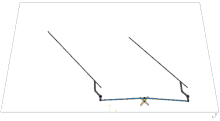Windscreen wiper
Almost all motor vehicles, including cars, trucks, buses, train locomotives, and watercraft with a cabin—and some aircraft—are equipped with one or more such wipers, which are usually a legal requirement.On some vehicles, a windscreen washer system is also used to improve and expand the function of the wiper(s) to dry or icy conditions.For these types of winter conditions, some vehicles have additional heaters aimed at the windows, embedded heating wire(s) in the glass, or embedded heating wire(s) in the wiper blade; these defroster systems can melt ice or help to keep snow and ice from building up on the windscreen.At least three inventors patented windscreen cleaning devices at around the same time in 1903; Mary Anderson, Robert Douglass, and John Apjohn.[10] Inventor William M. Folberth and his brother, Fred, applied for a patent for an automatic windscreen wiper apparatus in 1919, which was granted in 1921.In 1963, another form of intermittent wiper was invented by Robert Kearns, an engineering professor at Wayne State University in Detroit, Michigan.Ford executives rejected Kearns' proposal at the time, but later offered a similar design as an option on the company's Mercury line, beginning with the 1969 models.In March 1970, French automotive manufacturer Citroën introduced more advanced rain-sensitive intermittent windscreen wipers on its SM model.If the windscreen was relatively dry, the wiper motor drew high current, which would set the control circuit timer to a long delay for the next wipe.In 1945, John W. Anderson, founder of Trico rival Anco, filed a patent for a wiper with branched arms to keep the blade pressed uniformly against both curved and flat glass,[16] adaptable to almost any windscreen curvature.However, various Mercedes-Benz models and other cars such as the Volkswagen Sharan employ wipers configured to move in opposite directions (Fig.A cost benefit to the auto-maker occurs when wipers configured to move in opposite directions do not need to be repositioned for cars exported to right hand drive countries such as the UK and Japan.The Triumph Stag, Lexus and several US makes employ this method to cover more glass area where the windscreen is quite wide but also very shallow.5) called the "Monoblade", based on cantilevers, in which a single arm extends outward to reach the top corners of the windscreen, and pulls in at the ends and middle of the stroke, sweeping out a somewhat M-shaped path.Asymmetric wiper arrangements are usually configured to clear more windscreen area on the driver's side, and so are mostly mirrored for left and right-hand-drive vehicles (for example, Fig.On right-hand-drive models, a linkage allows the right-hand wiper to move outwards towards the corner of the windscreen and clear more area.Headlamp wipers have all but disappeared today with most modern designs relying solely on pressurized fluid spray to clean the headlights.This reduces manufacturing cost, minimizes aerodynamic drag, and complies with EU regulations limiting headlamp wiper use to glass-lensed units only (the majority of lenses today are made of plastic.)[24] Since 2012, nozzles are replaced on some cars (Tesla, Volvo XC60 2018-2021, Citroen C4 Cactus) by a system called AquaBlade, developed by the company Valeo.The rain-sensing wipers system currently employed by most car manufacturers today was originally invented and patented in 1978 by Australian, Raymond J. Noack, see U.S.A common alternative design used on ships, called a clear view screen, avoids the use of rubber wiper blades.

















The Windshield WiperwhippletreeCommonwealth EnglishAmerican Englishvehicle's front windowmotor vehiclestruckslocomotiveswatercraftaircraftpivotselectric motorpneumatic powerprecipitationpantographantifreezewindow washer fluidnozzlesheatersheating wire(s)defroster systemsheadlightsGeorge J. CapewellpianistJózef HofmannBirminghamMary AndersonGladstone AdamsWhitley BayJohn R. OisheiTieneninventorelectro-mechanicalpatent applicationthermalhydraulicautomotive engineeringLucas Industriessolid-state electronicRobert Kearnsengineering professorWayne State UniversityDetroithuman eyeblinksrate of current flow into a capacitorcapacitorvoltageFord Motor CompanyexecutivesMercury linepatent dispute2008 feature filmFlash of GeniusNew YorkerCitroënSM modelcurrentcircuitPneumatic motor4-bar linkagesparallelpneumaticvacuum motormanifold vacuumthrottleLincoln ContinentalLincoln Continental Mark IIIFord ThunderbirdCitroën 2CVnatural rubberEPDM rubberethylene propylene rubbergraphiteDKW-IFA F8 "Luxuscabriolet"East GermanyMercedes-Benz O 405 NHMercedes-BenzVolkswagen Sharanright hand drivecantileversRenault ClioTwingoScénicE60 5 SeriesE63 6 SeriesPeugeot 206Nissan Almera TinoMercedes-Benz W140SEAT AlteaSEAT LeónSEAT ToledoVAZ-1111 OkaFiat PandaSEAT MarbellaFiat UnoCitroën AXCitroën BXCitroën ZXSEAT IbizaJaguar XJsSubaru XTMercedes-Benz W124Mercedes-Benz O305school busestrolleybusesIkarus 415TKenworth T600Honda CR-XPorsche 928Triumph TR7DAF XFHino 700Toyota FJ CruiserJaguar E-TypeMG MidgetAustin Healey SpriteGMC Hummer EVfire trucksZIL-131Jeep WranglerUS militaryjeepneysHummer H1HUMVEEAlpine A310